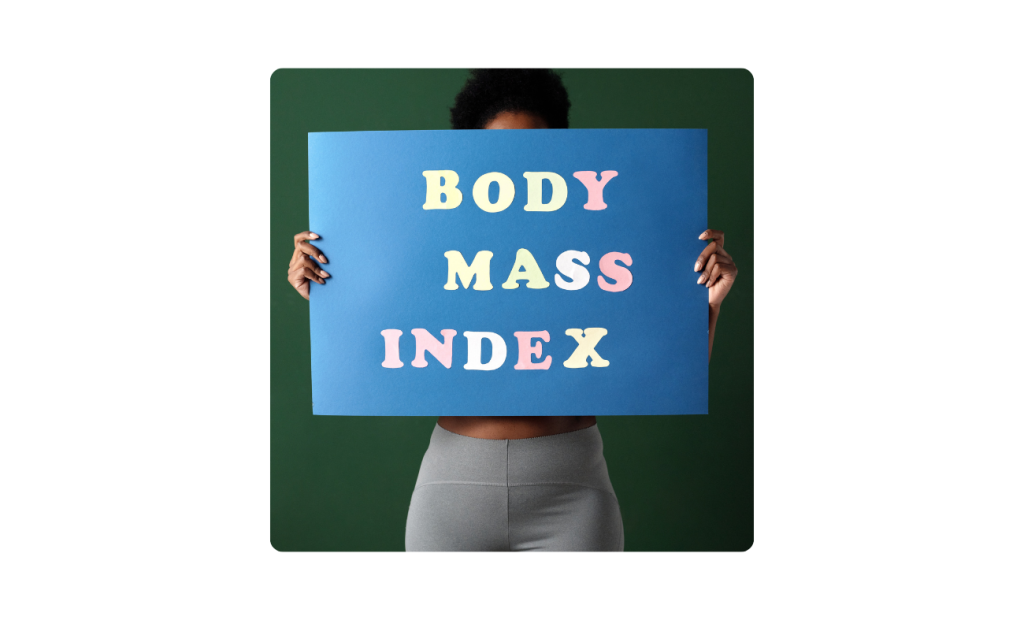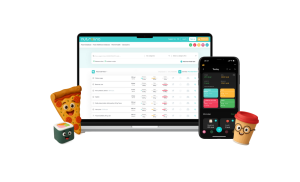What is BMI and why should you even care?
BMI (Body Mass Index) has been around since the 19th century. It’s used to quickly assess your weight in relation to your height – well, at least for adults. It doesn’t apply to kids, though. They have their own charts. You’ll find them here → Childhood Obesity and Malnutrition: How to Recognize It, Understand It, and Help Stop It
BMI is commonly used in population studies, in healthcare settings, or as a basic indicator of health risks.
👉 Specifically, it helps assess your risk of developing certain health problems, prevent them or even estimate the risk of early death. So yeah, it’s a quick and easy calculation. But… it’s far from perfect. We’ll get to that…
How do you calculate your BMI?
🔢 BMI = weight (kg) / height (m)²
Or just click on our calculator and get results that actually make sense – not just numbers. Nutrelino BMI Calculator
The downsides of BMI—followed by one big “BUT”.
BMI has its flaws. Quite a few, actually. It doesn’t take into account many things we now know about the human body.
Here’s what it ignores:
- your age
- your muscle mass (so if you work out regularly, it may not tell you much)
- your body fat percentage – nope, “I’m strong though” doesn’t save you
- where your fat is stored (which is actually a big deal)
The problem?
BMI was created in an era when people pulled carts, not scrolled on phones. They moved more. Sat less. Lived differently.
BMI doesn’t distinguish between fat and muscle.
So it’s totally possible to:
- have a high BMI but low body fat (like many athletes)
- or a low BMI but too much fat (aka “skinny fat”)
And unfortunately, the second case is way more common.
Many people who look slim actually have low muscle mass and too much fat – which is a problem. The same kind of problem you see with being overweight. Maybe even worse.
Why? Because we keep lying to ourselves with this illusion of “being lean = being healthy.”
Too much body fat can:
- trigger chronic inflammation
- weaken your immune system
- increase your risk of long-term health issues
And then there’s fat distribution. BMI doesn’t care. But we should.
Belly fat (called visceral fat) is especially dangerous.
It raises your risk of:
- heart disease
- high blood pressure
- type 2 diabetes
- gallbladder problems
- gout
So even if your BMI says you’re “normal,” that doesn’t mean you’re in the clear. You might still be carrying too much fat – you just don’t see it on the scale.
👉 One study showed that 39% of people with “normal” BMI had too much body fat.
On the flip side – if your BMI says you’re overweight or obese, there’s a 99% chance it’s right. Unless you’re a bodybuilder with visible abs…
And no, we don’t mean “I squat a lot but still have a belly” kind of strong. That doesn’t count.
Now let’s talk about the big “BUT.”
Yes, BMI has its flaws. We’ve made that pretty clear by now. And yet… you’ll still find it everywhere.
It’s widely used in research, in healthcare, and in public health guidelines. And yep – it’s still cited in thousands of scientific studies (even the newest ones).
Why?
Because it’s quick, cheap, and accessible. No labs, no 3D scanners—just height, weight, and a calculator.
Even doctors know BMI isn’t perfect. But when used wisely (and with a realistic view of the patient in front of them), it can be a pretty solid screening tool.
Sure, it’s not great at measuring actual body fat, but it’s still a decent way to gauge weight-to-height ratio. Especially for people who don’t do much strength training or have low muscle mass.
➡️ Let’s make one thing clear: It’s a quick filter. Not a final diagnosis.
So let’s sum it up:
- If your BMI says “normal,” you could still have too much fat and too little muscle (aka skinny fat).
- If it says “overweight” or “obese,” there’s a 99% chance it’s right.
Only real exception? Athletes with visible muscle mass. And no, “I’ve done some squats but still have a belly” doesn’t count. We’re talking about the 1% of seriously lean and muscular people.
Bottom line? BMI isn’t the enemy.
But if you want to know the real state of your body, don’t obsess over the number – look at your actual body fat. That’s what truly impacts your health.
💡 Fact:
Many people tend to underestimate what their BMI is actually telling them – especially when it points to overweight or obesity.
How to tell how much body fat you really have (no lab coat needed)
There are plenty of ways to estimate your body fat. Some are super accurate, some are more of a ballpark. But all of them can give you at least a general idea.
🪞 Visual estimate
Yep, just looking in the mirror can actually work. A little honesty and self-awareness go a long way.
You can also compare yourself to visual guides that show what different body fat percentages look like (for both men and women).


📲 Body fat calculator
Want something a bit more technical? Try an online calculator. This one’s not ours, but it does the job: Body Fat Calculator
Not rocket science, but good enough as a quick check. And yes, we’re working on our own version inside Nutrelino – to keep everything in one place.
🧪 Other ways to measure fat:
- Skinfold calipers – not glamorous, but effective (if you know what you’re doing).
- Bioimpedance scale – the “smart scale” you might already have at home. It gives you a fat percentage, but don’t treat it like gospel.
- Pro-level scans (DEXA, InBody, etc.) – more accurate, but also more expensive or harder to access.
💡 Pro tip: A bioimpedance scale is best for tracking changes over time – not for getting an exact number.
Weigh yourself on the same scale, under the same conditions, and you’ll see which way your progress is going.
What Your BMI range Really Means – and What It Might Be Hiding
Underweight (BMI < 18.5)
A slightly low BMI doesn’t always scream “problem” – but it can be the first warning sign of undernourishment. If you’re slim and feel good? Cool.
But if you’re constantly tired, catching every bug going around, or struggling to focus – don’t ignore it.
Being underweight increases your risk of:
- weak immune system
- chronic fatigue
- poor concentration
- fertility issues
- osteoporosis
- heart and circulatory problems
- and for smokers: higher risk of cancer, ulcers, and digestive disorders
➡️ Just because you look thin doesn’t mean your body is healthy. Underweight can be just as risky as obesity – it’s just harder to spot.
Healthy Weight (BMI 18.5–24.9)
This is the zone you want to be in.
Your health risks are lowest here – if you’re also eating decently and moving your body. Because healthy weight doesn’t automatically mean a healthy lifestyle.
📚 A study by Berrington de Gonzalez et al. (2010) showed that people in this range had the lowest risk of early death.
❗ Fact: Even within the “healthy” BMI range, there’s a difference.
📚 Epidemiologist Kaaks (2012) pointed out that having a BMI at the upper end of this range might still mean a higher cancer risk – especially if it’s driven by fat, not muscle.
Overweight (BMI 25–29.9)
You might feel fine… But the numbers say: risk is already on the rise.
Mild overweight can bring:
- high blood pressure
- increased risk of diabetes and certain cancers
- chronic inflammation, asthma, arthritis
- thyroid issues (yep, usually as a result – not the cause!)
And the myths? Nope, mild overweight isn’t healthier than normal weight. You can be strong, but if you’re also carrying too much fat – that strength isn’t doing what you think.
📚 Adams et al. (2006):
- 20 – 40% higher risk of early death with mild overweight
- over 150% higher with obesity
📚 Calle et al. (1999):
- BMI 25–27 → 30% higher risk of premature death
- BMI 27–29 → 60% higher risk
Mild overweight doesn’t mean you will get sick… But statistically, you’re definitely rolling the dice.
Obesity (BMI 30–34.9)
This is where change becomes urgent. And the sooner, the better. Find someone who can help – professionally and without empty promises.
Your body may already be waving the red flag:
- high blood pressure and cholesterol
- weakened immune system
- diabetes, asthma, depression
- thyroid issues
- joint and back pain
📚 Calle et al. (1999):
- Risk of early death in this BMI range = +120%
- For women, the risk of dying from cardiovascular disease was 310% higher compared to women with a BMI under 19.
👉 Want to dig deeper? Check out our article: Adult Obesity: How It Affects Your Health – and How to Take Back Control
Severe Obesity (BMI > 35)
At this point, it’s not just about health anymore. It’s about your life. This is your wake-up call. Change needs to happen – professionally, safely, patiently, and consistently.
Most common issues:
- heart disease and circulation problems
- diabetes, cancer
- spinal, joint, and breathing problems
- drastically lower quality of life
- immune and thyroid dysfunction
- mental health struggles and depression
📚 Calle et al. (1999):
- Risk of death in this range = +120%
- Obese women with a BMI over 35 had a 310% higher risk of dying from cardiovascular disease compared to women with a BMI under 19.
📚 Kitahara et al. (2014):
- Obesity can take 13.7 years off your life – and that’s not even counting how hard those years might be.
Yes. It’s more dangerous than smoking.
Want to know what shape your body’s really in?
BMI gives you the basics.
But if you want the full picture, you need to track your body fat, muscle mass, nutrition, and progress over time.
👉 And that’s exactly what Nutrelino helps you do. Clearly, simply – no guesswork needed.
Sources:
Conquering Fat Logic: how to overcome what we tell ourselves about diets, weight, and metabolism, Nadja Hermann
https://www.ncbi.nlm.nih.gov/pmc/articles/PMC4890841/
https://examine.com/nutrition/how-valid-is-bmi-as-a-measure-of-health-and-obesity/
https://www.ncbi.nlm.nih.gov/pmc/articles/PMC6469873/
https://pubmed.ncbi.nlm.nih.gov/11965822/
https://www.ncbi.nlm.nih.gov/books/NBK535456/
https://journals.sagepub.com/doi/10.1177/2047487312471759






